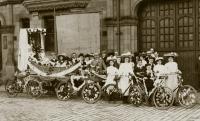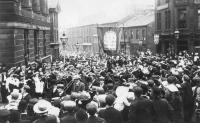
Trying Dry January? The Calder Valley has a Long History of Going Alcohol-Free!
In this guest blog, volunteer Sue explores the history of the temperance movement in the Calder Valley, which encouraged peope to stop dringking alcohol.
Dry January set me thinking about abstinence in general, and in particular the history of the temperance movement in the upper Calder Valley.
A quick search through the Digital Archive came up with pictures of smiling children holding a ‘Death to Alcohol’ banner, girls wearing large hats and white frocks holding decorated bicycles ready to set off on a Band of Hope parade (ALC01448), plus a VERY well attended Band of Hope parade in Todmorden (TAL00443)

Image ALC01448 from the Pennine Horizons Digital Archive.

Image TAL00443 from the Pennine Horizons Digital Archive
Band of Hope was a nationwide temperance organisation aimed at rescuing children from the evils of alcohol. Its roots were in the mid-19th century, but it still exists today as the children’s charity Hope UK. The charity's website explains the origins and early history of the organisation:
“In June 1847, Rev Jabez Tunnicliff visited a man who had once been a Sunday School teacher but was now a dying alcoholic. The man said to Mr Tunnicliff ‘I want you, if you think it worthwhile to say anything about me when I’m gone, to warn young men against the first glass.’”
The organisation functioned like a youth club for children. They had meetings, songs, festivals, magic lantern shows, competitions and every year crowned pageant queens.
Over the next 50 years the Band of Hope flourished: by 1897 membership was estimated at over 3,000,000 and Queen Victoria became the patron in her jubilee year.
The first Hebden Bridge and District Band of Hope Society was formed at Cross Lanes Methodist Church in 1865 and the first in Todmorden in 1869. Other churches and chapels followed suit and soon had their own branches.
To provide alcohol-free meeting places ‘coffee taverns’ opened, the first one in Todmorden being funded and built by John Fielden in 1880. There were also temperance hotels in both Todmorden and Hebden Bridge. (example of 1889 advert for Central Temperance Hotel Todmorden Milltown Memories, Issue 5, p12)
Although popular, the temperance movements were not always successful in their campaigns. In 1894 seven candidates stood in the local election – as part of a campaign to get the Hole in the Wall Inn closed down. Only one was elected, and their campaign was not successful (the new Hole in the Wall - built in 1899 - only closed down in 2012).
In the early years of the 20th century the temperance movement declined, with Hebden Bridge Band of Hope folding in 1952. While campaigns for temperance do not play a big part in mainstream culture today, the popularity of Dry January shows that people are still interested in exploring abstinence from alcohol.